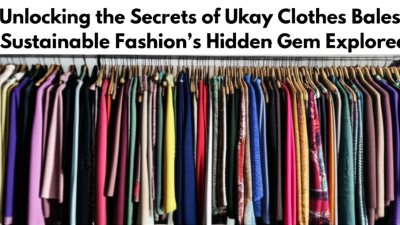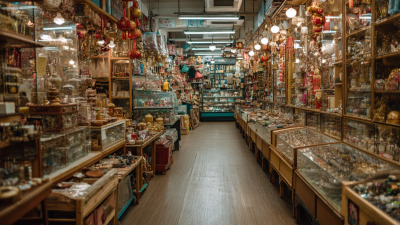Leave Your Message
In recent years, the fashion industry has faced increasing scrutiny over its environmental impact, prompting a shift towards more sustainable practices. Amidst this transformative landscape, "Ukay Clothes Bales" have emerged as a fascinating and practical solution for eco-conscious consumers. These bales, filled with secondhand clothes, offer not only a unique alternative to fast fashion but also a treasure trove of vintage and unique styles that cater to individual tastes.

This article delves into the secrets of Ukay Clothes Bales, exploring their origins, the process of production, and the benefits they bring to sustainable fashion. By shedding light on this hidden gem, we aim to inspire a deeper appreciation for upcycled clothing and its potential to redefine our fashion choices while promoting a more sustainable future. Join us as we uncover the allure and practicality of Ukay Clothes Bales in the quest for a more responsible wardrobe.
Ukay clothes, often found in bales of second-hand garments, represent a unique avenue for sustainable fashion. The rise of this market is not merely a trend but a response to the pressing issue of textile waste. Every year, millions of tons of clothing end up in landfills, contributing significantly to environmental degradation. By opting for ukay clothes, consumers have the opportunity to reduce this waste, giving a second life to garments that would otherwise be discarded.
Moreover, the environmental benefits of ukay clothes extend beyond waste reduction. The production of new textiles typically involves high carbon emissions—from the cultivation of raw materials to manufacturing processes. By choosing to purchase second-hand garments from ukay bales, individuals can significantly lower their carbon footprint.
This shift in consumer behavior not only supports sustainable practices but also fosters a culture of recycling and reusing, which is essential in combating climate change. In embracing ukay clothes, consumers can take an active role in nurturing a more sustainable future while enjoying the diversity and uniqueness of pre-loved fashion.
The ukay-ukay market has emerged as a vibrant segment within the sustainable fashion landscape, particularly in Southeast Asia. Recent reports indicate that Filipino consumers are leading the charge in embracing secondhand fashion, favoring thrifted items as a stylish yet environmentally conscious choice. This shift is not just a trend, but a movement, with platforms witnessing a surge in both buyers and sellers of ukay clothes, reflecting a growing awareness of sustainability among younger generations. Gen Z, in particular, has been instrumental in this transformation, driving consumption growth and redefining retail narratives through their commitment to eco-friendly practices.
However, the rise of the ukay-ukay market also raises questions about the broader implications of thrift shopping. While it provides a means to enjoy affordable fashion, issues such as the authenticity of secondhand items have surfaced, especially with critiques directed at certain stores for marketing new fast-fashion goods as reused. Reports suggest that around 30% of consumers express concerns over the ecological impact of both new and secondhand clothing markets, highlighting the ongoing struggle between fashion appetite and environmental sustainability. As the landscape evolves, the balance between style, quality, and eco-consciousness remains pivotal for consumers who are becoming increasingly discerning in their fashion choices.
Ukay clothes bales have emerged as a popular choice for both consumers and retailers, offering a unique and cost-effective solution in the realm of sustainable fashion. These bales, often composed of second-hand clothing, provide an affordable alternative to fast fashion, allowing consumers to shop with a budget while still enjoying a diverse range of styles. The low price point of ukay items makes it easier for shoppers to update their wardrobes without breaking the bank, promoting a more sustainable cycle of consumption that prioritizes reusability over waste.
For retailers, investing in ukay clothes bales can significantly enhance profit margins. With rising consumer demand for eco-friendly products, businesses that offer these resold items tap into a niche market that values environmental sustainability. Retailers benefit from lower inventory costs and can appeal to a growing demographic that prioritizes ethical purchasing decisions. By incorporating ukay clothes into their offerings, shops not only diversify their product lines but also align themselves with a global movement towards eco-conscious consumerism, ultimately solidifying their brand's reputation in a competitive market.
This chart illustrates the economic aspects of Ukay clothes bales, highlighting the cost per bale, average retail markup, and potential savings for consumers. The affordability of Ukay clothes makes them a sustainable fashion choice while benefiting both consumers and retailers.
The surge in popularity of ukay clothes bales can be attributed to a growing awareness of sustainability in fashion. Unlike the ephemeral trends of fast fashion, which often prioritize quantity over quality, ukay clothing offers a unique blend of durability and style.
Thrift shops play a crucial role in mitigating the environmental impact of textile waste, as they encourage consumers to embrace secondhand garments. This shift not only prolongs the lifespan of clothing but also promotes an eco-conscious lifestyle.
As consumers become more discerning, the comparison between ukay clothing and fast fashion becomes increasingly relevant. Fast fashion is notorious for its high turnover rate and poor-quality materials, resulting in a cycle of overconsumption and waste. In contrast, ukay clothing, often sourced from bales of pre-loved garments, presents a sustainable alternative that combines practicality with individuality.
By choosing to shop at these thrift stores, individuals can contribute to a more sustainable fashion industry while also discovering unique pieces that set them apart from the crowd.
The fashion industry is one of the largest contributors to environmental degradation, with a staggering 92 million tons of waste generated annually, according to the World Bank. In this context, Ukay clothes bales emerge as a sustainable solution that promotes circular fashion. These bales, composed of secondhand clothing, not only extend the life of textiles but also significantly reduce the demand for new garments, thereby conserving resources and minimizing waste. A report by the Global Fashion Agenda highlights that adopting circular fashion practices could reduce the industry’s greenhouse gas emissions by as much as 50% by 2030.
Ukay clothes play a pivotal role in recycling and reuse initiatives. By embracing this model, consumers are encouraged to rethink their purchasing habits, opting for pre-loved items over fast fashion. A survey conducted by ThredUp found that 70% of consumers are committed to sustainable practices, with thrifted clothing being one of the most popular choices. This shift not only benefits the environment but also provides economic opportunities in the resale market, valued at $36 billion in 2021, as reported by Market Research Future. The ripple effect of integrating Ukay clothes into everyday fashion exemplifies how individuals can contribute to a more sustainable future while enjoying unique and affordable clothing options.
| Dimension | Description | Impact |
|---|---|---|
| Material Composition | Ukay clothes are often made from a mix of cotton, polyester, and other blended fabrics. | Promotes recycling of textiles and reduces landfill waste. |
| Economic Accessibility | Ukay clothes provide affordable fashion options for diverse socioeconomic groups. | Enhances economic sustainability and accessibility to clothing. |
| Cultural Significance | Wearing Ukay clothes can reflect individual style and cultural identity. | Promotes diversity in fashion choices and self-expression. |
| Environmental Benefits | Reduces the demand for new textile production, lowering carbon footprints. | Contributes to the mitigation of climate change through sustainable practices. |
| Community Engagement | Local thrift shops and Ukay markets foster community interaction. | Strengthens social ties and community resilience. |






